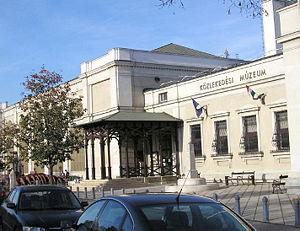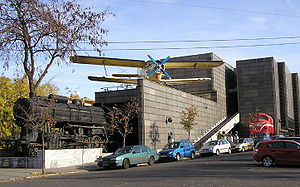
Transport Museum of Budapest
Encyclopedia


Europe
Europe is, by convention, one of the world's seven continents. Comprising the westernmost peninsula of Eurasia, Europe is generally 'divided' from Asia to its east by the watershed divides of the Ural and Caucasus Mountains, the Ural River, the Caspian and Black Seas, and the waterways connecting...
’s oldest transportation collections.
It is a must for railway connoisseurs and amateurs. This museum has a unique collection of locomotive
Locomotive
A locomotive is a railway vehicle that provides the motive power for a train. The word originates from the Latin loco – "from a place", ablative of locus, "place" + Medieval Latin motivus, "causing motion", and is a shortened form of the term locomotive engine, first used in the early 19th...
s and wagons on a 1:5 scale. This means that a locomotive of, for example, 10 m length is reproduced with all details in a 2 m length model. The models represent a wide range of railway technology. The museum shows also a locomotive and wagon in real size with a railway station of the 1900s.
In other parts of the museum are shown :
- The history of road traffic: horse-drawn and machine-driven vehicles, road and bridge building with a collection of old cars, motorcycles and bicycles.
- The history of sailing. Sailing from the prehistoric ages; the history of Hungarian boat manufacturing, showed by models.
- On a location deeper in the park there is a permanent exhibition about the history of flight and space flight, including original Hungarian and foreign airplanes, including a Junkers F-13, the first airplane in the world with metal frame-work. It also has the cabin of the first Hungarian astronautAstronautAn astronaut or cosmonaut is a person trained by a human spaceflight program to command, pilot, or serve as a crew member of a spacecraft....
, Bertalan FarkasBertalan FarkasBertalan Farkas was the first Hungarian cosmonaut and the first Esperantist in space. He is currently the president of Airlines Service and Trade...
. The development of engines and instruments and Modern rocket-techniques are demonstrated.
The history of town traffic shows the public traffic in Buda
Buda
For detailed information see: History of Buda CastleBuda is the western part of the Hungarian capital Budapest on the west bank of the Danube. The name Buda takes its name from the name of Bleda the Hun ruler, whose name is also Buda in Hungarian.Buda comprises about one-third of Budapest's...
and Pest before the appearance of trams and buses. The Omnibusz and the first trams in Budapest
Budapest
Budapest is the capital of Hungary. As the largest city of Hungary, it is the country's principal political, cultural, commercial, industrial, and transportation centre. In 2011, Budapest had 1,733,685 inhabitants, down from its 1989 peak of 2,113,645 due to suburbanization. The Budapest Commuter...
.
Visitor information
- Address: 11 Városliget körút, XIVZuglóZugló is the official name of the 14th district of Budapest , the capital of Hungary. It is a large and mixed neighborhood, with communist era style highrise apartments sprinkled between decently kept one house residential streets...
Budapest
Southeastern corner of City Park
City Park (Budapest)
Városliget is a public park in Budapest, Hungary close to the city centre. It is located in District XIV of Budapest. Its main entrance is Heroes' Square , one of Hungary's World Heritage sites.-Name:The area was formerly called Ökör-dűlő, meaning "Oxmeadow"...
- Open from 1 November to 28 March:
- On weekdays (except Monday): 10:00 am to 4:00 pm
- On Saturday and Sunday: 10:00 am to 5:00 pm
- From 29 March to 31 October:
- On weekdays (except Monday): 10:00 am to 5:00 pm
- On Saturday and Sunday: 10:00 am to 6:00 pm
- Entrance fee: 1000 FtHungarian forintThe forint is the currency of Hungary. It is divided into 100 fillér, although fillér coins are no longer in circulation. The introduction of the forint on 1 August 1946 was a crucial step of the post-WWII stabilization of the Hungarian economy, and the currency remained relatively stable until...

